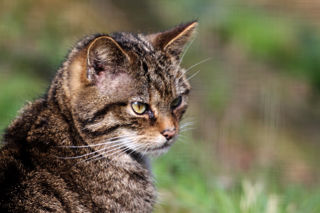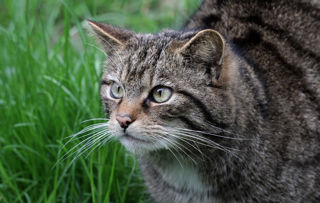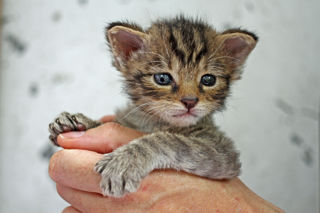
European Wildcat
Felis silvestris
Wildcats are native to the UK but now exist only in the highlands of Scotland. Though they may look like your tabby cat, wildcats are not related to the domestic cat and are much bigger and bulkier with a large bushy striped tail. As the name suggests they are wild and cannot easily be tamed, even from a kitten. They are able to interbreed with the domestic cat, which weakens their genetics. Wildcats hunt on small animals, birds and reptiles in the moorlands and woodlands of Scotland.
Behaviour
Nocturnal and solitary, with a highly territorial nature. Territories are marked with urine and faeces deposited on landscape features such as boulders and tree trunks. Dens (within old tree roots, rocky crevices and old badger setts) are used during the day to shelter from bad weather and for rearing young.
UK Status
Wildcats are currently now only found in Scotland, but not on Scottish islands. They were once common throughout the UK, but have undergone a dramatic decline since the 16th century and are now on the brink of extinction.
Threats
Hybridisation with feral and domestic cats is the biggest threat to current Scottish wildcat populations. Additionally, feral and domestic cats also transmit diseases to wildcats. Active persecution is also a problem, even though illegal in Scotland, non-specific predator control (e.g. snares) in Europe has resulted in population declines. Habitat loss has been a factor, pushing the small populations into further remote areas. However wildcats can do well in agricultural areas, preying on the increased rodent numbers, although these areas are usually associated with high populations of feral domestic cats as well.

Description
Very similar to the domestic cat. A bit heavier and larger (2-7kg). Dark thick body stripes with no white patches. Thick bushy tail, with black stripes and black tip.
Distribution
The wildcat is found throughout Africa, Europe, and south and central Asia. There are four major subspecies or groups which are distinct geographically. The European wildcat was widespread throughout Europe, and began declining between the 1700-1900s.
Habitat
Inhabits a range of habitats, ranging from deserts and scrub, to dry and mixed forest. In Scotland, their key habitats are woodlands, and upland moorland areas.
Diet
Rabbits and other small mammals are their main prey. Birds, invertebrates, reptiles and carrion are also taken, but less often.
Wildwood inside information
Our wildcats are a part of the national captive breeding programme and we have a long successful history of breeding the species. Wildwood is keen to be a key contributor to reintroducing the wildcat back into the wild in the UK. For more information on our wildcat captive breeding and research, please visit our conservation page.
Family facts
Due to their ferocious nature, they are commonly known as the “Highland Tiger”.



